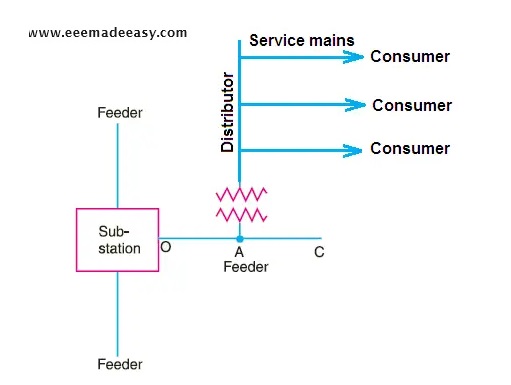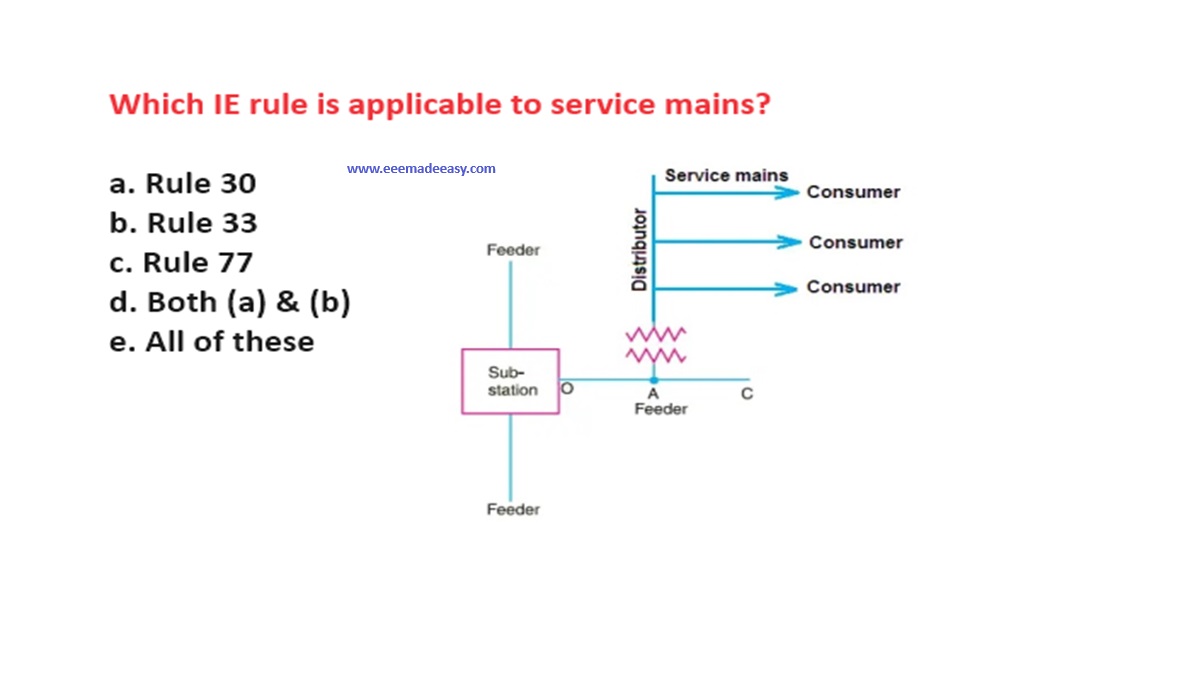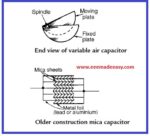Which IE rule is applicable to service mains?
a. Rule 30
b. Rule 33
c. Rule 77
d. Both (a) & (b)
e. All of these
ANSWER: All of these
Read : [PDF]IE Rules|Indian Electricity Rules 1956
IE Rule 30: Service lines and apparatus on consumer’s premises
IE Rule 33: Earthed terminal on consumer’s premises
IE Rule 77: Clearance above ground of the lowest conductor
What is Service Mains?
The overhead line or underground cable connecting the distribution line to the consumer’s premises is called service mains or service connection or service line.
The service mains terminates at the point where the supply conductor enters the consumer’s Energy meter.

IE Rule 30,33 and 77
IE Rule 30
Service lines and apparatus on consumer’s premises- (1) The supplier shall ensure that
all electric supply lines, wires, fittings and apparatus belonging to him or under his control,
which are on a consumer’s premises, are in a safe condition and in all respects fit for
supplying energy and the supplier shall take due precautions to avoid danger arising from such
premises from such supply lines, wires, fittings and apparatus.
(2) Service lines placed by the supplier on the premises of a consumer which are underground
or which are accessible shall be so insulated and protected by the supplier as to be secured
under all ordinary conditions against electrical, mechanical, chemical or other injury to the
insulation.
(3)The consumer shall, as far as circumstances permit, take precautions for the safe custody
of the equipment on his premises belonging to the supplier.
(4) The consumer shall also ensure that the installation under his control is maintained in a
safe condition.
IE Rule 33
Earthed terminal on consumer’s premises
(1) The supplier shall provide and maintain on the consumer’s premises for the consumer’s use, a suitable earthed terminal in an accessible position at or near the point of commencement of supply, as defined under rule 58, Provided that in the case of medium, high or extra-high voltage installation the consumer shall, in addition to the aforementioned earthing arrangement, provide his own earthing system with an independent electrode.
Provided further that the supplier may not provide any earthed terminal in the case of
installations already connected to his system on or before the date to be specified by the State
Government in this behalf if he is satisfied that the consumer’ s earthing arrangement is
efficient.
(2)The consumer shall take all reasonable precautions to prevent mechanical damage to the
earthed terminal and its lead belonging to the supplier.
(3)The supplier may recover from the consumer the cost of installation on the basis of
schedule of charges notified in advance and where such schedule of charges is not notified,
the procedure prescribed, in sub-rule(5) of rule 82 will apply.
IE Rule 77
Clearance above ground of the lowest conductor
(1) No conductor of an overhead
line, including service lines, erected across a street shall at any part thereof be at a height
of less than-
(a) for low and medium voltage lines 5.8 metres
(b) for high voltage lines 6.1 metres
(2) No conductor of an overhead line, including service lines, erected along any street shall at any part thereof be at a height less than-
(a) for low and medium voltage lines 5.5 metres
(b) for high voltage lines 5.8 metres
(3) No conductor of an overhead line including service lines, erected elsewhere than
along or across any street shall be at a height less than
(a) for low, medium and high voltages lines upto and including 11,000 volts,if bare 4.6 metres
(b) for low, medium and high voltage lines upto and including 11,000 volts, if insulated 4.0 metres
(c) for high voltage lines above 11,000 volts 5.2 metres
(9) For extra-high voltage lines the clearance above ground shall not be less than 5.2
metres plus 0.3 metre for every 33,000 volts or part thereof by which the voltage of the line exceeds 33,000 volts; Provided that the minimum clearance along or across any street shall not be less than 6.1 metres.
Clearance between conductors and trolley wires
(1) No conductor of an overhead line crossing a tramway or trolley bus route using trolley wires shall have less than the following clearances above any trolley wire-
(a) low and medium voltage lines 1.2 metres Provided that where an insulated conductor suspended from a bearer wire crosses over a trolley wire the minimum clearance for such insulated conductor shall be 0.6 metre.
(b)high voltage lines up to and including 11,000 volts 1.8 metres
(c) high voltage lines above 11,000 volts 2.5 metres
(d)extra-high voltage lines 3.0 metres
(2) In any case of a crossing referred to in sub-rule(1), whoever lays his line later in
time, shall provide the clearance between his own line and the line which will be crossed
in accordance with the provisions of said sub-rule;
Read Also
- [Updated]List of IS Codes Electrical standards|IS 732, IS 3043 etc|Indian electrical standards
- [Class A,B,C]Electrical Contractor Licence in Kerala Class A, Class B, Class C|How to get Electrical Contractor License Kerala|Electrical Supervisor Permit A and B
- [Complete Guide] Class A Electrical Contractor Licence Application, Renewal
- [PDF]IE Rules|Indian Electricity Rules 1956
- Which IE rule is applicable to service mains?|Indian Electricity Rule
- [PDF] Electricity Act 2003|Indian Electricity Act 2003 PDF
- Which act is used to regulate the Indian power sector today?
- Indian Electricity Rules MCQ|IE Rules Questions
Latest Posts in EEE Made Easy
- RRB JE CBT 2 Exam Date 2025 Postponed|RRB JE CBT 2 Exam Date
- [PDF]RRB JE Result 03/2024 Cut off, Selected no of candidates for all regions
- [PDF]Final Answer Key Junior Instructor Mechanic Agricultural Machinery|643/2023 Solved Question paper
- Acoustics MCQs|Industries Extension officer|IEO 2025
- LASER MCQs| Industries Extension officer|IEO 2025
- Practical Types of Capacitors
- [PDF] Syllabus JUNIOR INSTRUCTOR MECHANIC AGRICULTURAL MACHINERY|643/2023 Syllabus Kerala PSC




